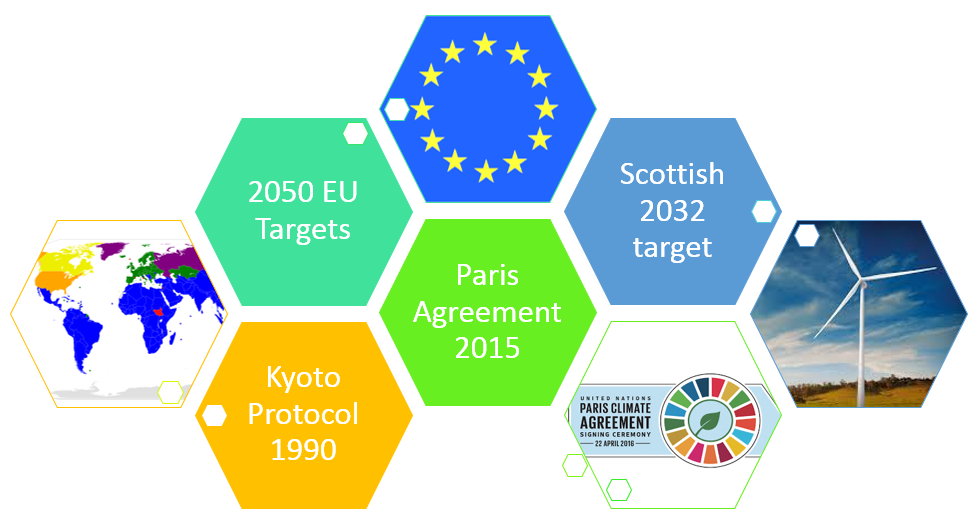Wind energy is Scotland’s fastest growing renewable technology with an installed capacity of 5328MW (March 2015) [1]. Favourable weather conditions and government incentives have encouraged energy providers, as well as small scale projects, to introduce these systems onto the grid [1]. In the Glasgow area, Whitelee Windfarm (operated by Scottish Power) is the UK’s largest onshore windfarm with an installed capacity of 539MW [2].
Wind power will be essential in order to achieve the Scottish Government’s 2032 goals of generating 100% of Scotland’s annual gross electricity consumption from renewable sources [3]. However, as wind energy is a non-dispatchable resource, it will not be able to consistently meet the energy demand alone.
The intermittent nature of wind- and the inability to accurately predict weather far in advance- creates some challenges when aiming to achieve 100% renewable electricity. Wind farms are often shut down in the event of an oversupply being predicted, due to their unpredictability [4]. Dispatchable energy from conventional gas plants are used to meet demand in these situations. Although predictable, combustion of natural gas results in emissions which the government intends to eliminate over the next two years [3].
In 2017, the National Grid paid approximately £108 million in constraint payments to wind farm operators to stop generating renewable electricity [4].
Wind power will be essential in order to achieve the Scottish Government’s 2032 goals of generating 100% of Scotland’s annual gross electricity consumption from renewable sources [3]. However, as wind energy is a non-dispatchable resource, it will not be able to consistently meet the energy demand alone.
The intermittent nature of wind- and the inability to accurately predict weather far in advance- creates some challenges when aiming to achieve 100% renewable electricity. Wind farms are often shut down in the event of an oversupply being predicted, due to their unpredictability [4]. Dispatchable energy from conventional gas plants are used to meet demand in these situations. Although predictable, combustion of natural gas results in emissions which the government intends to eliminate over the next two years [3].
In 2017, the National Grid paid approximately £108 million in constraint payments to wind farm operators to stop generating renewable electricity [4].
Policy and Regulations
In the past two decades, concern over the levels of emissions has resulted in the creation of a framework designed to reduce harmful emissions. In 1997, the Kyoto protocol acknowledged that developed countries are primarily responsible for the high levels of emissions as a result of 150 years of industrial activity. This agreement committed parties to a set of internationally binding emission reduction targets, placing the highest burden on these developed nations under the principle of “common but differentiated responsibilities” [5].
Additionally, in December 2015, 195 countries adopted the first ever universal, legally binding global climate deal at the Paris Climate Conference (COP15). This agreement “sets out a global action plan to put the world on track to avoid dangerous climate change by limiting global warming to well below 2°C”. In order to achieve this, a key element was agreed to reduce emissions, with an emissions peak occurring as soon as possible and a reduction in figures thereafter [6]. The EU 2050 roadmap similarly suggests that there should be an 80% reduction in greenhouse gas emissions on the 1990 figure, which all sectors must contribute to [7].
In light of these commitments, the Scottish Government set the goal of generating the equivalent of 100% of Scotland’s annual gross electricity consumption through renewable sources by 2020 [3].
Additionally, in December 2015, 195 countries adopted the first ever universal, legally binding global climate deal at the Paris Climate Conference (COP15). This agreement “sets out a global action plan to put the world on track to avoid dangerous climate change by limiting global warming to well below 2°C”. In order to achieve this, a key element was agreed to reduce emissions, with an emissions peak occurring as soon as possible and a reduction in figures thereafter [6]. The EU 2050 roadmap similarly suggests that there should be an 80% reduction in greenhouse gas emissions on the 1990 figure, which all sectors must contribute to [7].
In light of these commitments, the Scottish Government set the goal of generating the equivalent of 100% of Scotland’s annual gross electricity consumption through renewable sources by 2020 [3].
[1] Department for Business, Energy & Industrial Strategy (2015) Renewable electricity capacity and generation.
[2] Whitelee Windfarm. (2018) Available: https://www.scottishpower.co.uk/whitelee/ [Accessed: 11 May 2018].
[3] Renewable Energy. (2018) Available: http://www.gov.scot/Topics/Business-Industry/Energy/Energy-sources/19185 [Accessed: 5 May 2018].
[4] Mendick, R. (2018) Wind farms paid £100m to switch power off. The Telegraph Available: https://www.telegraph.co.uk/news/2018/01/08/wind-farms-paid-100m-switch-power/ [Accessed: 11 May 2018].
[5] KP Introduction | UNFCCC. (2018) Available: https://unfccc.int/process/the-kyoto-protocol [Accessed: 5 May 2018].
[6] Paris Agreement - Climate Action - European Commission. (2018) Available: https://ec.europa.eu/clima/policies/international/negotiations/paris_en [Accessed: 5 May 2018].
[7] 2050 Low-Carbon Economy - Climate Action - European Commission. (2018) Available: https://ec.europa.eu/clima/policies/strategies/2050_en [Accessed: 5 May 2018].
[2] Whitelee Windfarm. (2018) Available: https://www.scottishpower.co.uk/whitelee/ [Accessed: 11 May 2018].
[3] Renewable Energy. (2018) Available: http://www.gov.scot/Topics/Business-Industry/Energy/Energy-sources/19185 [Accessed: 5 May 2018].
[4] Mendick, R. (2018) Wind farms paid £100m to switch power off. The Telegraph Available: https://www.telegraph.co.uk/news/2018/01/08/wind-farms-paid-100m-switch-power/ [Accessed: 11 May 2018].
[5] KP Introduction | UNFCCC. (2018) Available: https://unfccc.int/process/the-kyoto-protocol [Accessed: 5 May 2018].
[6] Paris Agreement - Climate Action - European Commission. (2018) Available: https://ec.europa.eu/clima/policies/international/negotiations/paris_en [Accessed: 5 May 2018].
[7] 2050 Low-Carbon Economy - Climate Action - European Commission. (2018) Available: https://ec.europa.eu/clima/policies/strategies/2050_en [Accessed: 5 May 2018].
